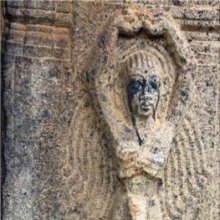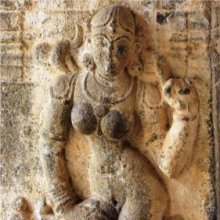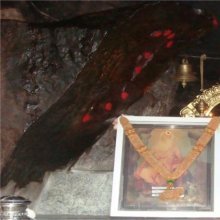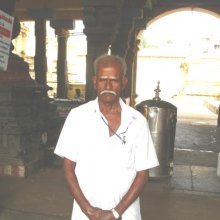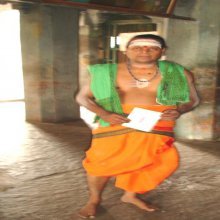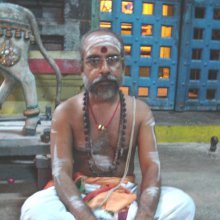Murugan, Murukan: 9 definitions
Introduction:
Murugan means something in Hinduism, Sanskrit, the history of ancient India, Tamil. If you want to know the exact meaning, history, etymology or English translation of this term then check out the descriptions on this page. Add your comment or reference to a book if you want to contribute to this summary article.
Images (photo gallery)
(+1 more images available)
In Hinduism
Shilpashastra (iconography)
Source: Red Zambala: Hindu Icons and Symbols | Inner Circle IVAs the second son of Lord Śiva, Murugan the embodiment of skilful action, just as Gaṇeśa is the personification of wisdom. Skilful action (kuśala karma) is that which is direct at Ātmā bodha —self-realization. The several and collective human perfections are all personified in Murugan. When all the five senses and the mind as the co-ordinating factor are sublimated and directed towards enlightenment then one attains super-consciousness.
Lord Murugan was born from the Tejas or intense energy of Lord Śiva in order to relieve the gods of the oppression of Tārakāsura who had gained a boon of invincibility from Brahmā.
Source: Shodhganga: The significance of the mūla-beras (śilpa)Murukan (Murugan) is the name of a deity depicted in various temples:
The Arunachaleswara Temple (Aruṇācaleśvar) in Thiruvannamalai (Tiruvaṇṇāmalai), [Śiva temple]: (a) Murukan is represented as seated in sukhāsana on his peacock. He is represented with four hands. (b) There is also the sannidhi for Murukan with his consorts Valli and Deivānai to the right of the entrance. Murukan is found standing,
The Jambukeswarar Temple in Tiruvānaikoyil (Thiruvanaikaval), [another Śiva temple].—(a) Murukan is found standing is vaiśākha-sthānaka with four hands. (b) Murukan is also found with six faces and six pairs of hands. Valli and Deivānai are found on either side of Murukan. (c) Murukan is also found standing in vaiśākha posture with two hands.
The Nellaiappar Temple at Tirunelveli, [another Śiva temple].—Murugan (Murukan) is represented as seated in sukhāsana with six pairs of hands. While depicting in Bharatanatyam, he is represented in aindra-maṇḍala. Valli and Deivānai (the wives of Murukan) are found on either side of Murukan.
The Kamakshi Amman Temple in Kanchipuram, [Goddess or Devī temple].—There is the sannidhi of Murukan at the entrance of the sannidhi of Arūpa Lakṣmī. Murukan is represented as seated with the left leg folded, which in dancing terms is called aindra-maṇḍala. In iconographic terms, this posture is called sukhāsana. He is represented with four hands.
The Meenakshi Temple in Madurai (or Madura), [another Goddess or Devī temple].—Murukan is represented as seated with the left leg folded and six pairs of hands and six heads. He is seated on a peacock, his vehicle. Usually the six pairs of hands hold different emblems.
The Subramanya Swamy Temple (or Subramaṇya Svāmi Temple) in Thiruparankundram or Parankundram (Paraṅkuṉṟam), [Murugan temple].—The sanctum of Murukan represents Murukan in sitting posture with sage Nārada (to the right of Murukan) and Deivānai (to the left of Murukan) near him. Sūrya and Candra are found above the sanctum of Murukan. Murukan is represented as seated with the left leg folded and the right leg hanging down. In dance, Murukan is depicted as aindra-sthānaka. He is represented with four hands. [...] When depicted in iconographic terms, Murukan is represented as seated in sukhāsana pose of the sitting posture.

Shilpashastra (शिल्पशास्त्र, śilpaśāstra) represents the ancient Indian science (shastra) of creative arts (shilpa) such as sculpture, iconography and painting. Closely related to Vastushastra (architecture), they often share the same literature.
Shaivism (Shaiva philosophy)
Source: Murugan: The Iconography of MuruganMuruga, the second son of Siva and Parvati, is variously known as Subrahmanya, Shanmukha, Karttikeya, Skanda, Devasenapati, Śikhivahana Saravanabhava, etc. The cult of Muruga was a well developed one ever since the Cankam period in Tamilaham. The iconography of Subrahmanya is elaborated at length in the Kumaratantra and Śrītattvanidhi.
Source: DSpace at Pondicherry: Siddha Cult in Tamilnadu (shaivism)Murugan (or Murukan) is also called Subrahmaṇya. He is the second son of Śiva. He is also called Skanda, Murukan, Kandasāmi, Supraya Kumāra, Saravana, Kārtikeya, Kāṅgeyan, Āṟumukha, Ṣanmukhan, Velāyuda, Sūra Samhāra Mūrti, Mailerivelan and Tārakājit. Murugan is praised as a great Siddha of Bāla-varga group. He rides on the peacock, the killer of serpents. ‘Serpent’ stands for the cycle of years or the cycle of births. ‘Peacock’ stands for the killer of time and thereby birth and death.
Each of the six faces of Murugan (Murukan) brings out various philosophical meanings namely,
- Diffuses radiance and dispels darkness,
- Casts a gracious look and grants boons,
- Guards the sacrifice of brāhmanas,
- Discovers the hidden truths and enlightens minds of sages,
- Destroys the enemies in fierce battles,
- Loves and enjoys Vaḷḷi.
The six abodes of Murukan are:
- Palani (Murukan obtaining the fruit of wisdom and appearing as ānṭi, a person owing nothing of his own);
- Svamimalai (Murukan teaching the meaning of praṇava to Śiva);
- Tiruchendur (Devasenāpati aspect and rendition of Sūrapadma),
- Thiruparankundram or Parankundram (Murukan’s marriage with Devasena),
- Tiruttani (Murukan’s marriage with Valli),
- Palamutircolai (Murukan’s holy darśana in the company of two wives).

Shaiva (शैव, śaiva) or Shaivism (śaivism) represents a tradition of Hinduism worshiping Shiva as the supreme being. Closely related to Shaktism, Shaiva literature includes a range of scriptures, including Tantras, while the root of this tradition may be traced back to the ancient Vedas.
General definition (in Hinduism)
Source: Palani: HinduismThe Names of Palani Lord Murugan
- Aranmakan
- Ārumukhan
- Ārumîn Kādalan
- Ārumugathamudhu
- Azhagan
- Bākuleyan
- Bala Subramanian
- Chetty
- Dandapani
- Dandāyudhapāni
- Devasenāpati
- Teyvayānai Kantan
- Ganapati Izhankilai
- Gangai Maindan
- Gangai Siruvan
- Gangeyan
- Gnāna Panditan
- Gauri Nandanan
- Guhan
- Guru
- Kadamban
- Kandan
- Kārttikeyan
- KatireShan
- Katir Kāmattu Îcan
- Kothandapani
- Kozhikkodiyon
- Kuzhandai
- Kulandai Velāyudhan
- Kumaran
- Muttaian
- Muttuk Kumaran
- Muttu Kumāraswāmi
- Pazhani Āndavar
- Pazhani Appan
- Pāvaki
- Sangat Talaivan
- Saravanan
- Saravana Bhavan
- Senaik Kāppon
- Senāpati
- Sendan
- Senthil Vadivelan
- Sevvel
- Seyon
- Sevarkodiyon
- Shanmukhan
- Shanmukha Nāthan
- Shanmukha Sundaram
- Shanmukha Vadivelan
- Shanmukha Velan
- Siddhan
- Shikivāhanar
- Silamban
- Shringaravelan
- Shivakumāran
- Sūr Thandinthon
- Sūr Pakaivan
- Subrahmaniyan
- Sundara Shanmukhan
- Kumarappan
- Kumāraswāmi
- Kumāra Vel
- Kumaresan
- Kundrakkudiyon
- Kundrenindhon
- Kuriñji Vendan
- Kuzhagan
- Māl Marugan
- Malaimakal Makan
- Manggai ūrdi
- Manoharan
- Mayil Vāhanan
- Mayon Marugan
- Murukan
- Muruga Vel
- Sundara Vadivelan
- Suresan
- Swāmi
- Swāmināthan
- Thanikāchalam
- Thārakar Serron
- Thakappanswāmi
- Vadivelan
- Valli Kantan
- Valli Manālan
- Vanaipaka-verindon
- Velan
- Vel
- Vishākan
- Yanaikkum Kuzhakan
Murugan is another name for Kartikeya and is often referred to as "Tamil Kadavul" (meaning "God of Tamils"). Extant Sangam literature works, dated between the 3rd century BCE and 5th century CE glorified Murugan, "the red god seated on the blue peacock, who is ever young and resplendent," as "the favoured god of the Tamils."
According to the Tirumurugarruppatai, Murugan was the presiding deity of the Kurinci region (hilly area).
According to the Tamil devotional work, Thiruppugazh, "Murugan never hesitates to come to the aid of a devotee when called upon in piety or distress".
Source: Shodhganga: The significance of the mūla-berasMurukan (Murugan) is the younger son of Śiva and Pāvatī. He is called by various names such as Subrahmaṇya, Kārtikeya, Skanda, Āṟumukha, Alakar (Aḷakar), and Palaniāṇṭi. In the temples erected for Murukan, the chief deity is Murukan surrounded by subsidiary images. In Śiva temples, the image of Murukan is fashioned as parivāra-deva or subsidiary image.
Murukan is considered as the god of beauty, knowledge, honesty, courage and obedience. Murukan is also considered a child god, but still the devotees come to Him and pray for protection, good qualities and courage. The śaktivel or the velāyudha that is held in the hand of Murukan is an important accessory. It is said that by holding this weapon, the three energies of Śakti namely the iccā-śakti (energy of desire), the jñāna-śakti (energy of wisdom), and the kriyā-śakti (energy of action) are within Murukan. The other attribute held in Murukan’s hand is the vajrāyudha. Two śūlas placed end to end make the vajra. It symbolizes the non-dual character of the Divine Being and also the fusion of Śiva and Pārvatī. Thus, the devotee feels fully satisfied after the darśana of the Lord because he feels that on seeing Murukan, he has seen the trinity and the three goddesses. Children pray to him for knowledge as He was the one to teach Brahmā and Śiva the meaning of the Oṃ praṇava mantra at Svāmimalai. He is the god of courage. He killed many Asuras. And He has a large number of devotees who worship with great love and devotion.
India history and geography
Source: academia.edu: Minor Chiefs and "Hero" in Ancient TamilakamMurukaṉ (a God) is a name related to the historical geography and rulers of ancient Tamil Nadu, occuring in Sangam literature such as the Akanāṉūṟu and the Puṟanāṉūṟu.—Notes: (Puṟam. 23, 299), Muruku (ibidem 56, 259)

The history of India traces the identification of countries, villages, towns and other regions of India, as well as mythology, zoology, royal dynasties, rulers, tribes, local festivities and traditions and regional languages. Ancient India enjoyed religious freedom and encourages the path of Dharma, a concept common to Buddhism, Hinduism, and Jainism.
Languages of India and abroad
Tamil dictionary
Source: DDSA: University of Madras: Tamil LexiconMurukaṉ (முருகன்) noun < முருகு. [murugu.] [K. muruga, M. murugan.]
1. Youth; கட்டிளமை யோன். (திவா.) [kattilamai yon. (thiva.)]
2. See முருகக்கடவுள். [murugakkadavul.] (பத்துப்பாட்டு பக். [pathuppattu pag.] 56, உரை. [urai.])
3. One possessed by Skanda; வெறியாட்டாளன். (பிங்கலகண்டு) முதியாளோடு முருகனை முறையிற் கூவி [veriyattalan. (pingalagandu) muthiyalodu muruganai muraiyir kuvi] (கந்தபு. வள்ளலார்சாத்திரம்ி. [kanthapu. valli.] 155).
4. Chief of the desert tract; பாலை நிலத்தலைவன். (அரு. நி.) [palai nilathalaivan. (aru. ni.)]
5. An inebriating preparation. See மாஜூன். [majun.] Local usage
Tamil is an ancient language of India from the Dravidian family spoken by roughly 250 million people mainly in southern India and Sri Lanka.
See also (Relevant definitions)
Starts with: Murukanatal.
Ends with: Malai-murugan, Nellai Murugan.
Full-text (+93): Valli, Palani, Skanda, Murukanatal, Svamimalai, Shanmukha, Tirumurukarruppatai, Pancamurtti, Tiruchendur, Mayuranatha, Markka-cakayatevar, Deivanai, Murukakkatavul, Thiruparankundram, Murukavel, Aturnton, Patin-enkannan, Tarakasura, Tiruttani, Shaktivel.
Relevant text
Search found 8 books and stories containing Murugan, Mūrukan, Murukan, Mūrugan, Murukaṉ, Murugaṉ; (plurals include: Murugans, Mūrukans, Murukans, Mūrugans, Murukaṉs, Murugaṉs). You can also click to the full overview containing English textual excerpts. Below are direct links for the most relevant articles:
The Religion and Philosophy of Tevaram (Thevaram) (by M. A. Dorai Rangaswamy)
Nayanar 16: Muruga (Muruka) < [Volume 4.1.1 - A comparative study of the Shaivite saints the Thiruthondathogai]
Chapter 4.5 - Puranic personalities (in the Tevaram) < [Volume 2 - Nampi Arurar and Mythology]
Chapter 94 - Thirumuruganpoondi or Tirumurukanpunti (Hymn 49) < [Volume 3.7 - Unto the last]
Middle Chola Temples (by S. R. Balasubrahmanyam)
Temples in Mambakkam < [Chapter II - Temples of Rajaraja I’s Time]
Temples in Tiruppattur (Tiruppidavur) < [Chapter IV - Temples of Rajendra I’s Time]
Temples in and around Madurantakam (by B. Mekala)
Appendix 2: Thiru Venkateswara (Kadapperi) Temple Layout
Appendix 3: Thiru Aatcheeswarar Temple Layout
Atcheeswarar Temple at Acharapakkam < [Chapter 4 - Prominent Temples in Madurantakam Taluk]
Reviews < [October – December, 1999]
A Living Flame < [April – June, 1993]
Who’s Who among our Contributors < [April – June, 1994]
Diaspora of Bhuta (Daiva) worshipping cult—India and Indonesia (by Shilpa V. Sonawane)
Part 12 - Submerged Lands in Ancient Indian Literture < [Chapter 4 - Inter-Disciplinary Analysis]
Later Chola Temples (by S. R. Balasubrahmanyam)
Temples in Magaral < [Chapter XIV - Temples of Rajaraja III’s Time]
